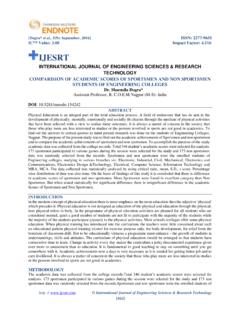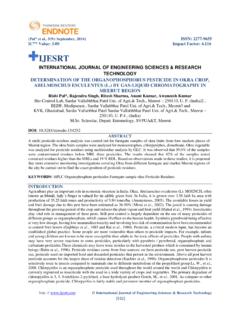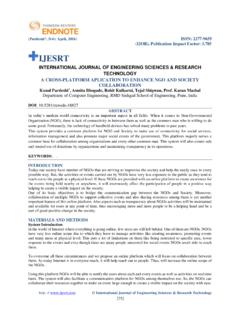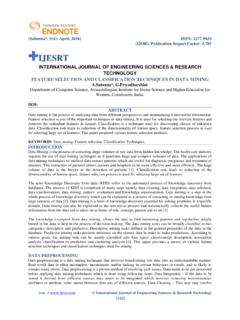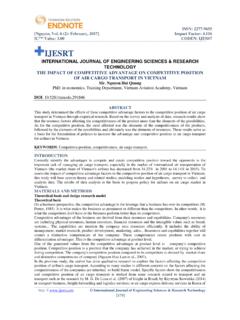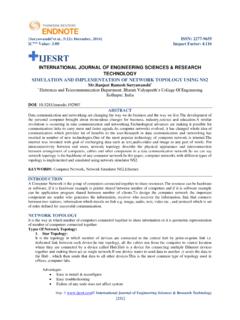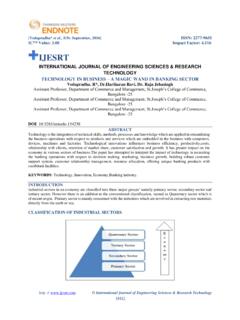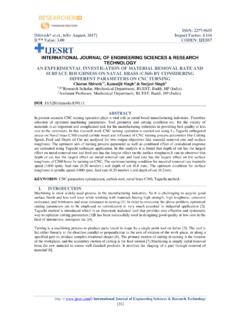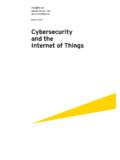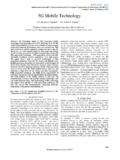Transcription of ISSN: 2277-9655 et al., IC™ Value: 3.00 CODEN: …
1 ISSN: 2277-9655 [Sekar* et al., 6(8): August, 2017] Impact Factor: IC Value: CODEN: IJESS7 http: // International Journal of Engineering Sciences & Research Technology [135] IJESRT INTERNATIONAL JOURNAL OF ENGINEERING SCIENCES & RESEARCH TECHNOLOGY AN EMPIRICAL STUDY ON INTERNET PROTOCOL IPV6 IN NETWORKING N. Sekar*1, Ms. N. Shanmuga Priya2 & Dr. SNS Rajalakshmi3 * Research Scholar (PT), College of Arts & Science College, (Autonomous), Coimbatore-49 (CT)., , Assistant Professor, Department of Computer Application, (PG), College of Arts & Science College, (Autonomous), Coimbatore-49 3 College of Arts & Science College, (Autonomous), Coimbatore-49 DOI: ABSTRACT The internet protocol IPv4 has met requires for years, but the number of addresses, while huge is finite. It has several shortcomings which are unavoidable and complicate such exhausted address space, security issues, non-availability of auto-configuration and in some cases present a obstacle to, the advance improvement of the Internet.
2 The resolution to mitigate this problem was the development of the new IPv6 protocol which enlarges the address space from 32-bits to 128-bits. IPv6 assembles a high address space, superior address design and better safety among other profits. IPv6 distribution necessitates deep and careful firm to minimize network disruption and ensure that the profits of IPv6 are accessed. Due to the issues of IPv4, now-a -days IPv6 is extremely popular in associations, corporations and Internet Service Providers (ISP). In this paper, we aim to provide a Literature Survey which describes the various techniques to implement IPv6 transition most optimal method to increase the network performances. KEYWORDS: IPV6, ISP,Transition, Dual stack, Tunnel. I. INTRODUCTION A Network is simply defined as collection of interdepended hosts, via some shared media which can be wired or wireless.
3 Computer networks allow its hosts to allocate and swap the data about the information over the media. Network can be a classified as Local Area Network (LAN) connected across an office or Metro Area Network (MAN) spanned across a city or Wide Area Network (WAN) which can be connected across cities and colonies [1]. Internet Protocol states that a set of technical rules that conclude how computer relates over a network. There are two important versions are used which are Internet Protocol version 4 (IPv4)and Internet Protocol version 6 (IPV6). IPv4 is a connectionless protocol for use on packet-switched networks. It manages on a greatest effort deliverance model, in that it does not warranty delivery, nor does it declare appropriate sequencing or avoidance of replacement delivery. These portions, counting data integrity, are addressed by an upper layer transmission protocol, such as the Transmission Control Protocol (TCP).
4 IPv6 provides an identification and location system for computers on networks and routes traffic across the Internet. It provides other technical benefits in calculation to a better addressing space. In scrupulous, it permits hierarchical address allotment methods that assist route aggregation towards the Internet, and thus frontier the extension of routing tables. The employ of multicast addressing is extended and simplified, and provides additional optimization for the deliverance of services. Device mobility, security, and configuration aspects have been considered in the design of the protocol. The most important variation between IPv4 and IPv6 is the number of IP addresses. There are 4,294,967,296 IPv4 addresses. In IPv6, 340,282,366,920,938,463,463,374,607,431, 768,211,456 IPv6 addresses. The practical execution of the Internet vestiges the same with both versions and it is likely that both versions will continue to operate concurrently on networks well into the scope of future work.
5 Finally, many networks that use IPv6 support both IPv4 and IPv6 addresses in their network. In this paper we discuss briefly IPv6 network design consideration for service provider network environments. ISSN: 2277-9655 [Sekar* et al., 6(8): August, 2017] Impact Factor: IC Value: CODEN: IJESS7 http: // International Journal of Engineering Sciences & Research Technology [136] II. NETWORKING ARCHITECTURE In networking various independent hosts are connected with each other over a communication network, among the entire computers one host must act as a master or server node which executes job allotment to the sub nodes that are valid for performing the task. Figure 1. Architecture of Network III. IPV6 IPv6 is also identified as IP next generation: it is measured evolutionary from IPv4, as it does not make a essential change to IPv4 and the major concept stays the identical, but some features have been added, which help to get better performance and shows a high-quality service for clientele.
6 In IPv6, the NAT was eliminated, which is considered an advantage. Anyway, the configuration is simple with IPv6 as it can be done stateless configuration. The IP address is a mixture of the MAC address for the border and the prefix from the router; in common the DHCP is not used, but it can be used with DNS. The IPv6 size is 128 bits, comprised of Hexadecimal digits which are able to provide addresses, which are sufficient to give a sole address to each device for nowadays and for upcoming days. Each four digits are separated by a colon which provides eight parts; the zeroes can be mislaid to make the address smaller as shown in figure 2. Figure 2. IPv6 addressing IPv6 describes the global routing easier than IPv4. There is fewer outcomes on resources and recollection, which helps to get better performance and be extra competent. The protection is provided end to end by encryption, which is included within IPV6.
7 The traffic in IPv4 can be unicast, multicast or broadcast. With IPV6 the broadcast is no longer available due to its elevated consumption of resources. However, a broadcast can be sent from within a multicast. 1. Unicast Addressing: the unicast is to send the packet for one destination unique address. 2. Multicast Addressing: the multicast addressing is to send the packet for a cluster of addresses. The IPv6 use the ff00::/8 as a prefix for multicast. The type of addressing use two protocols to know which IPs in the similar group for multicast there are Multicast Listening Discovery protocol (MLD) and MLDv2. 3. Anycast Addressing: when there are numerous parallel destinations in different areas the unicast use to send the packets to the secret destination from the sender. IV. LITERATURE REVIEW The paper A Survey on Next Generation Internet Protocol:IPv6 by Dipti Chauhan and Sanjay Sharma describes that the development of Internet evolution, the evolution from Internet Protocol Version 4 to Internet Protocol version 6 has turn into inevitable and fairly immediate.
8 Internet Assigned Numbers Authority (IANA) ISSN: 2277-9655 [Sekar* et al., 6(8): August, 2017] Impact Factor: IC Value: CODEN: IJESS7 http: // International Journal of Engineering Sciences & Research Technology [137] has to conclude bushed the global IPv4 address space, which foliage the community no choice but pushes ahead the IPv6 transition process. IANA has ultimately run out IPv4 address space, the Internet is bound to enter the IPv6 era. Towards, IPv4 networks will coexist with IPv6 networks for a extensive time during the transition. The IPv6 transition process should be sturdy and smooth. Hence, the IPv4-IPv6 coexisting networks should sustain the availability of both IPv4 and IPv6, and support IPv4- IPv6 interconnection as well [2]. In this work Analysis of Packet Transmission Overhead of IPv4 and IPv6 through Simulation Nitul dutta , IPv4 gives better response, but still the important grounds for assuming IPv6 is the need for huge address space, refuge, and Quality of Service (QoS) features.
9 Hence IPv4 network is also necessary where these particular features of IPv6 are less significant, consequently the require for the co-existence of mutually protocols is necessary. To make subsistence of both the versions of the protocol together, some mechanisms of interoperability is described.[5] In this paper A Detail Comparative Review on IPv4/IPv6 Dual Stack Co-existence Techniques Piyush Sharma1, , This paper covers the special transition techniques that were exploited for the evolution between IPv6 networks to IPv4 networks and vice versa. The whole appraisal confirms the proficient way of transition is IPv6 Rapid Development method. The work is to take out the most well-organized method as evaluated to IPv6 Rapid Development is on course as it leads to large overhead and it is not appropriate for enormous mobile networks [6]. In this article Performance Analysis of IPv6 Dual-Protocol Stack and Tunnel Transition Adarsh Misra1, Harsha Chawla states that depending on investigation transition technique of the dual stack protocol, IPv6, 6 to 4 tunneling technique and ISATAP tunnel network recital are calculated and observed depending on program realized.
10 In general, results showed that the dual stack protocol IPv6 network has better performance as compared to 6 to 4 technique, dual stack protocol IPv4 and ISATAP technique [7]. In this work A Detail Comprehensive Review on IPv4-to-IPv6 Transition and Co-Existence Strategies Priya Bali , describes that the rate of operation for Dual-Stack is additional than particular stack for operators since they have to carry both stacks. If it is hard for operators to move honestly to native IPv6, then they can go execute evolution technologies. According to their onclusion, the next best transition technology to deploy in the network is NAT64 [9]. In this paper A Study of the Technology Transition from Ipv4 to Ipv6 for an ISP Daniel Enache , This paper sheded the light on IPv4 and IPv6, look into the necessities of an ISP network and present three mechanisms that will make the transition from IPv4 to IPv6 smoother: Translation, Tunnel and Dual-Stack [10].
